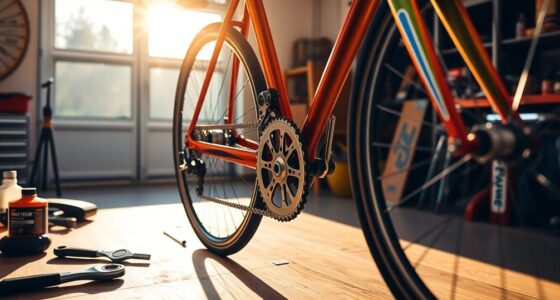To set up your bike tech, you'll need some essential tools like Allen keys, a floor pump, and cable snips. Start by carefully unboxing and assembling—removing packaging and fitting your handlebars and wheels. Inflate your tires to the correct pressure and adjust your suspension according to your weight. Make final adjustments to the saddle and handlebars, then check your gear and brake configurations for smooth operation. Keep going to discover more tips for getting your bike ready!
Key Takeaways
- Gather essential tools like Allen keys, Torx keys, and a floor pump for a complete bike setup.
- Carefully unbox your bike, removing packaging materials without damaging components, and secure the handlebars into the stem.
- Inflate tires to the recommended pressure and ensure proper seating to avoid pinch flats.
- Adjust saddle height and handlebars for comfort, ensuring all bolts are tightened to manufacturer specifications.
- Test gear shifts and brakes for functionality, making necessary adjustments for a safe ride.
Essential Tools for Bike Setup
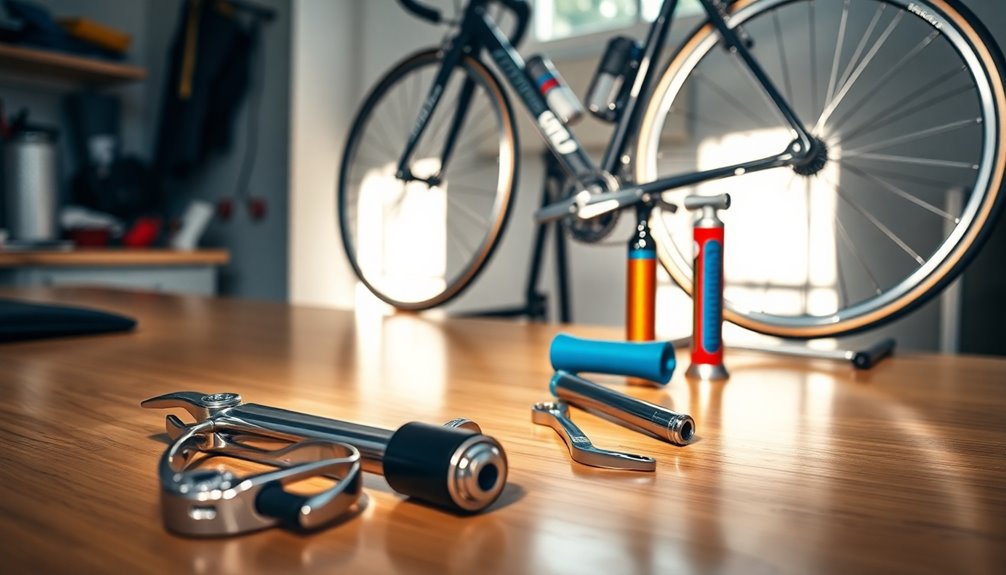
When setting up your bike, having the right tools can make all the difference.
You'll want a set of Allen keys or hex wrenches to secure various components, making certain everything's tight and ready for your exciting new ride.
Don't forget Torx keys, especially for brake and gear setups.
A floor pump is vital to inflate your tires to the correct pressure, which boosts both performance and safety.
Take care to use assembly grease during installation; it reduces friction and guarantees smooth operation of moving parts.
Finally, have cable snips or scissors handy for safely removing packaging materials without damaging your bike or its components.
Make sure you've got these essentials to enjoy a hassle-free setup!
Unboxing and Initial Assembly
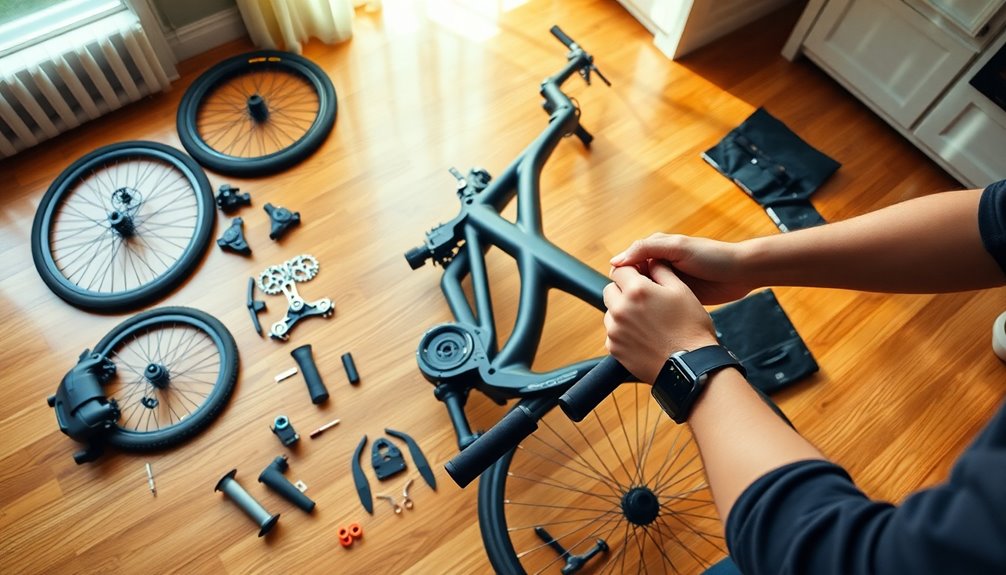
After gathering the right tools, it's time to unbox your bike and start the initial assembly.
Carefully cut through the packaging with scissors, avoiding sharp staples to protect your bike. Remove all packaging materials, including masking tape and zip ties, handling components like handlebars and rear mech gently.
Cut through the packaging with care, avoiding sharp staples, and gently remove all materials while handling components like handlebars and rear mech.
Here's what to focus on during assembly:
- Fit the handlebars securely into the stem, ensuring they're aligned.
- Remove brake pad spacers without touching the brake levers.
- Install the wheels carefully, aligning the brake discs for proper function.
- Check the bike's overall condition, ensuring all components meet the manufacturer's specifications.
Once everything's in place, you're set to roll into the next steps of your bike setup!
Tire and Suspension Preparation
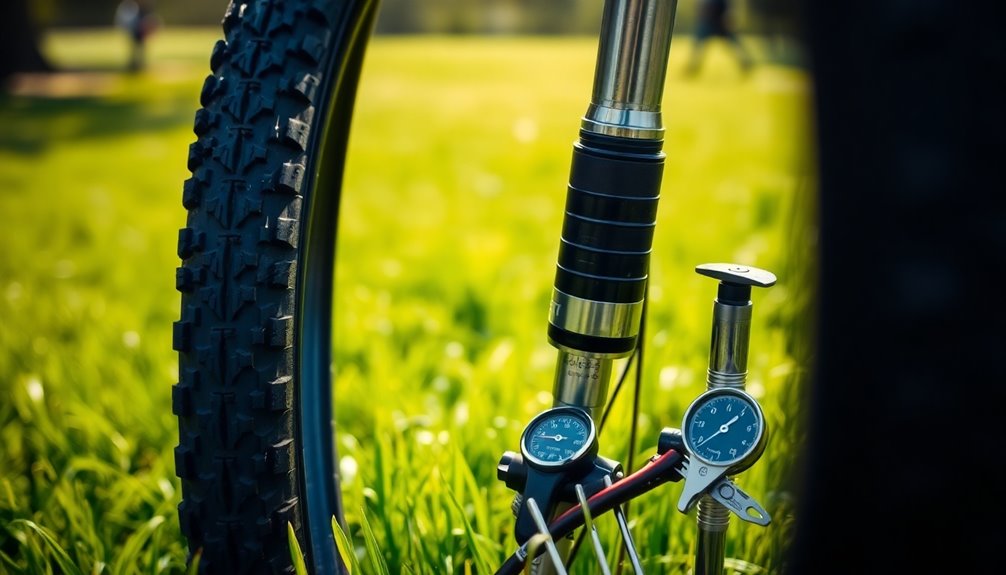
To guarantee your bike performs at its best, start by preparing the tires and suspension properly. Inflate your tires to the manufacturer-recommended pressure, typically between 30-50 PSI for mountain bikes and 80-130 PSI for road bikes.
Check the tire sidewalls for specific PSI recommendations based on size and type. Make sure the tires seat evenly on the rims to prevent pinch flats and guarantee control while riding.
Next, use a shock pump to adjust the suspension pressure according to your weight and riding style, generally setting it to 15-20% of your body weight in pounds.
Finally, inspect the suspension components for any signs of wear or damage, and perform maintenance as needed to keep everything functioning smoothly.
Final Adjustments and Safety Checks
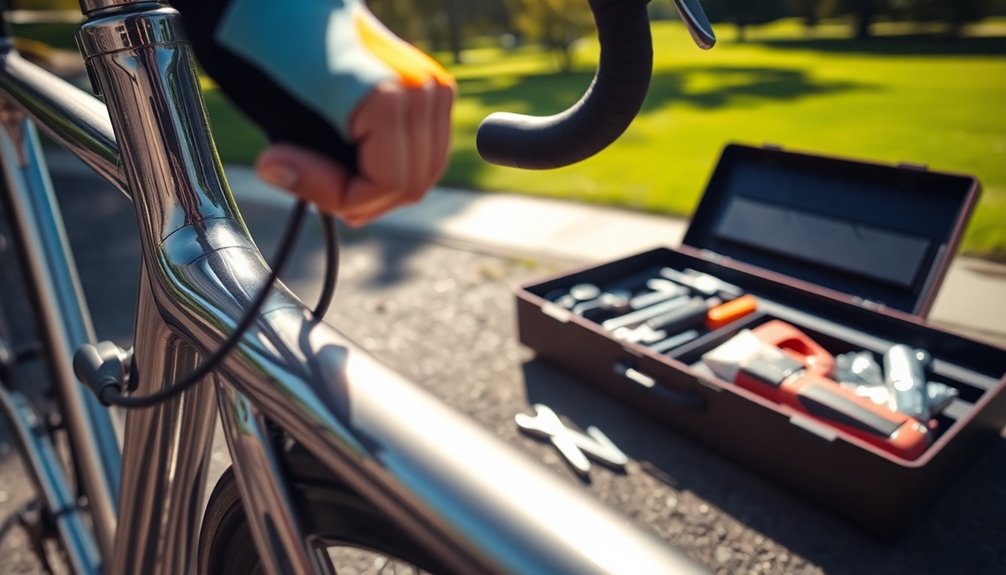
Making final adjustments and safety checks is essential for guaranteeing your bike is ready for the ride ahead.
Start by adjusting your saddle height and angle for proper leg extension, aiming for a slight bend in your knee at the lowest pedal point. Next, align your handlebars with the front tire and tighten the handlebar bolts to the specified torque settings.
Don't forget to inspect all components for secure fittings:
- Check that brake pads aren't touching the rim or rotor.
- Conduct a thorough bolt check from the handlebars downwards.
- Personalize lever positioning for comfort and accessibility.
- Verify all bolts are tightened to manufacturer specifications.
These steps will help prevent mechanical failures and guarantee a safer ride.
Gear and Brake Configuration

Getting your gear and brake configuration right is essential for a smooth and safe ride. Start by running through all your gears after setup to confirm they shift smoothly. If not, adjust the rear derailleur.
For your brakes, check the cable routing; in the UK, your right hand should control the front brake. Position the brake levers for your comfort, guaranteeing easy access and control while riding.
If you want to switch configurations, consult online videos for guidance tailored to your riding style. Before your first ride, perform a thorough brake check to verify everything's responsive and safe.
Proper setup helps avoid accidents and enhances your overall riding experience.
Frequently Asked Questions
How Do I Become a Bicycle Technician?
To become a bicycle technician, start by enrolling in a bicycle repair course or workshop for hands-on experience.
Consider getting certified through organizations like the NBDA or UBI to boost your credibility.
Familiarize yourself with essential tools like adjustable wrenches and tire levers.
Gain practical experience by volunteering or working at a local bike shop.
Finally, keep up with the latest bike technology and trends through online resources and community forums.
How to Correctly Set up a Bike?
To set up your bike, start by swiftly securing the saddle, ensuring it's snug and at the right height.
Next, neatly navigate the handlebars into the stem, locking them in place.
Inflate the tires to their proper pressure, then adjust the suspension settings to suit your weight.
Finally, finalize all fasteners with a thorough bolt check, making sure everything's tight and tidy before you take that thrilling first ride!
Should Your Legs Fully Extend on a Bike?
No, your legs shouldn't fully extend on a bike.
You want a slight bend at the knee when the pedal's at its lowest point. This position helps you maintain power and comfort while cycling, reducing the risk of strain or injury.
Aim for a knee angle of about 25 to 30 degrees. Adjust your saddle height incrementally, testing as you ride to find the perfect balance for your cycling style.
What Regular Maintenance Should Be Done on a Bike?
When it comes to bike maintenance, you don't want to let the grass grow under your feet.
Regularly check your tire pressure to avoid poor handling. Clean and lubricate your chain every 100-150 miles for smooth shifting.
Inspect your brakes to guarantee they're safe and effective.
Don't forget to perform a monthly bolt check and clean your bike often, keeping it in tip-top shape and ready for your next ride!
Conclusion
Now that you've got your bike tech set up, it's time to hit the road and feel the wind in your hair! Like a well-tuned instrument, a finely adjusted bike can turn every ride into music for your soul. Remember, regular maintenance keeps your ride smooth and safe, so don't skip those checks. Enjoy the journey ahead, and let every pedal push take you closer to your next adventure! Happy riding!




